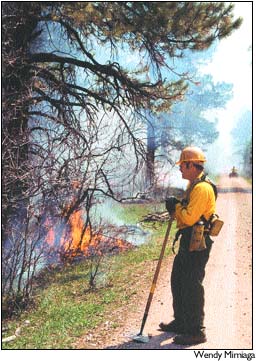|
May 15, 2001
By Janelle Holden Where thereís smoke, thereís fire ó as the saying goes ó but unlike last summerís rain of ashes, the smoke recently lingering over Montezuma County was generated by a series of controlled fires. On Friday, the U.S. Forest Service completed its spring prescribed burns on the Mancos-Dolores District of the San Juan National Forest. Forested lands near Dolores totaling nearly 1,450 acres were this yearís target. Acreage near Boggy Draw and near the Dolores-Norwood Road north of Dolores was burned earlier in the month by fire crews using hand-drip torches. The last of the fires was started with ping-pong balls loaded with napalm and dropped from a helicopter into the Haycamp Mesa/Rock Canyon area southeast of Dolores. "Once you hit 500 acres, itís more efficient to do with a helicopter, and itís safer for the people working in the field," explained Ron Klatt, the Haycamp "burn boss" and fire-management officer at the Columbine Ranger District. The helicopter is outfitted with an "aerial ignition dispenser," a bureaucratic name for a ping-pong-ball shooter. The dispenser punctures the balls, which are filled with potassium permangate, and injects antifreeze to start a chemical reaction. Once the balls land on the ground, it takes 20 to 40 seconds for each to ignite. A helicopter and heli-tack crew like the ones used on the Haycamp fire are not cheap. It costs $900 a flight hour for their time. According to Tom Kelly, a fire-management officer at the Dolores Ranger Station, the Haycamp fire was the first time in "recent history" that the district used a helicopter to start a fire. The Haycamp fire involved more than 800 acres, and had the helicopter not been involved, it would have taken three days to complete, rather than one. Shortening the fireís time span is important in keeping the smoke to a minimum and meeting the stringent air-quality standards of the Colorado Department of Health and Environment. "The biggest thing about managing smoke is not surprising people," said Ann Bond, a public-affairs specialist for the Forest Service. The Forest Service goes to great lengths to inform surrounding residents of the impending smoke. Ironically, the smoke from the Haycamp Mesa fire unexpectedly drifted over to Durango last weekend, where surprised residents called in to complain. Since the prescribed burn on the Cerro Grande National Forest raged out of control last May and burned many homes in Los Alamos, N.M., the Forest Service is putting a greater emphasis on contingency planning in case a fire happens to blaze out of control. "We make sure everything is in place before we start a fire," said Don Geesling, a fire-management officer at the Dolores Public Lands Center. Geesling explained that if the fire managers do not stay within the planned "prescription" for the fire, they could be held personally responsible for any damage that results. Spring fires, with high moisture both in the ground and in the air, generally keep flames low, burning the undergrowth and ground debris, but leaving the trees standing. The intent of a prescribed burn is not to burn all the vegetation to the ground, but to remove some of the surrounding vegetation that could fuel a lightning-strike summer fire that might rage out of control. "It also improves wildlife habitat and decreases wildfire intensity," Bond explained. All of the prescribed burns are funded through the $1.8 billion National Fire Plan appropriated by Congress this fiscal year to help reduce the risk of future wildfires and repair areas burned by last summerís wildfires. In 2000, wildfires burned more than 7 million acres nationwide, costing the Forest Service more than $2 billion to fight over 90,000 separate fires. Last yearís firefighters responded to 330 wildfires in Southwest Colorado. Thirteen air tankers flew more than 400 missions on 30 large fires, including two at Mesa Verde National Park. Another $118 million has been allocated by Congress to be used to help private-property owners reduce the risk of fires around their homes. The Forest Service plans to burn about 20,000 acres of public lands per year across southwestern Colorado this year. An additional prescribed fire is planned for 300 acres 16 miles northwest of Dolores this fall, as well as several mechanical thinning projects on BLM land. |
||
|
Copyright © 2001 the Cortez Journal.
All rights reserved. |
